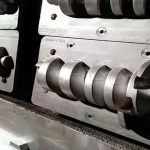When it comes to 3D printing technology, I believe that all friends in the School of mold Materials will be familiar with it. The 3D printing or additive manufacturing we usually see in the media generally refers to the same technology. This technology is based on digital model files and uses bondable materials such as powdered metal or plastic to construct objects by printing layer by layer.
In which areas can metal 3D printing materials be applied?
Metal 3D printing materials have a wide range of applications, such as petrochemical engineering applications, aerospace, automobile manufacturing, injection molds, light metal alloy casting, food processing, medical treatment, papermaking, power industry, jewelry, fashion, etc.
However, because of the material properties of metal 3D printing materials, they have specific application areas. Therefore, the process of selecting metal 3D printing materials is a process of weighing multiple factors. Moreover, 3D printing metal cannot be weighed solely by the parameters of the metal 3D printer. Each metal material has its own characteristics, including application, function, stability, durability, aesthetics, and economy. All are designers. Factors to consider.
What are the metal 3D printing materials?
Nowadays, the metal powders used in metal 3D printers at home and abroad generally include:
Tool steel, martensitic steel, stainless steel, pure titanium and titanium alloys, aluminum alloys, nickel-based alloys, copper-based alloys, cobalt-chromium alloys and so on.
【Tool Steel and Martensitic Steel】
Take tool steel and martensitic steel as examples. The applicability of tool steel comes from its excellent hardness, wear resistance and deformation resistance, as well as its ability to maintain cutting edges at high temperatures. Die H13 hot work tool steel is one of them, which can withstand process conditions of uncertain time; martensitic steel, taking martensite 300 as an example, is also called “maraging” steel, which has high strength in the aging process , Toughness and dimensional stability are well known. They are different from other steels because they are carbon-free and belong to intermetallic compounds, which are hardened by the metallurgical reaction of rich nickel, cobalt and molybdenum. Due to its high hardness and wear resistance, Martensite 300 is suitable for many mold applications, such as injection molds, light metal alloy casting, stamping and extrusion, etc. At the same time, it is also widely used in aerospace, high-strength fuselage parts And racing parts.
【Stainless steel】
Stainless steel is different from carbon steel. The current chromium content is different. The steel alloy with the lowest 10.5% chromium content, stainless steel is not easy to rust and corrode. At present, there are three main types of stainless steel used in metal 3D printing: austenitic stainless steel 316L, martensitic stainless steel 15-5PH, and martensitic stainless steel 17-4PH.
Austenitic stainless steel 316L, with high strength and corrosion resistance, can drop to low temperature in a wide temperature range, can be used in aerospace, petrochemical and other engineering applications, and can also be used in food processing and medical fields.
Martensitic stainless steel 15-5PH, also known as maraging (precipitation hardening) stainless steel, has high strength, good toughness, corrosion resistance, and can be further hardened, and is ferrite-free. At present, it is widely used in aerospace, petrochemical, chemical, food processing, papermaking and metal processing industries.
martensitic stainless steel 17-4PH, still has high strength and high toughness up to 315℃, and super corrosion resistance, with the laser processing state can bring two excellent ductility.
【Alloy】
The most widely used metal powder alloys for metal 3D printing materials are mainly pure titanium and titanium alloys, aluminum alloys, nickel-based alloys, cobalt-chromium alloys, copper-based alloys, etc.
Pure titanium and titanium alloy
The pure titanium currently used in the market, also known as commercial pure titanium, is divided into grade 1 and grade 2 powder, grade 2 is stronger than grade 1, and it is also corrosion resistant for most applications. Because pure titanium grade 2 has good biocompatibility, it has a wide range of application prospects in the medical industry.
Titanium is the key to the titanium alloy industry. At present, the titanium alloys used in metal 3D printing are mainly titanium alloy grade 5 and titanium alloy grade 23. Because of their excellent strength and toughness, combined with corrosion resistance, low specific gravity and biocompatibility, they are used in aerospace and automobile manufacturing. It has a very ideal application, and because of its high strength, low modulus, and strong fatigue resistance, it is used in the production of biomedical implants. Titanium alloy grade 23, with higher purity, is the same dental and medical titanium grade as the god grade.
Link to this article:What are the metal 3D printing materials?
Reprint Statement: If there are no special instructions, all articles on this site are original. Please indicate the source for reprinting:Mold Wiki,Thanks!^^

